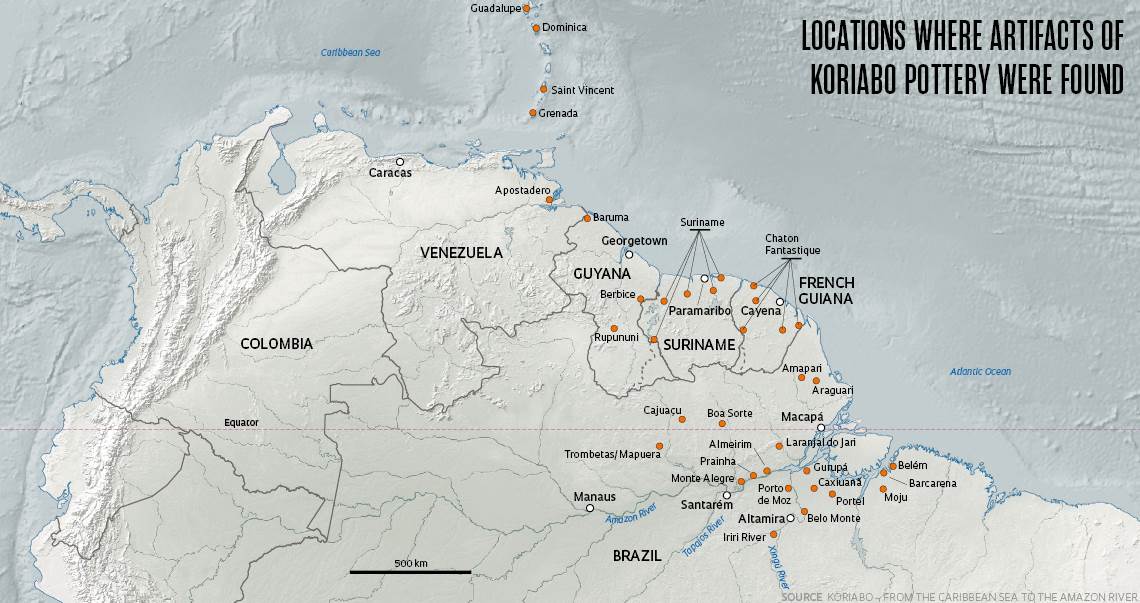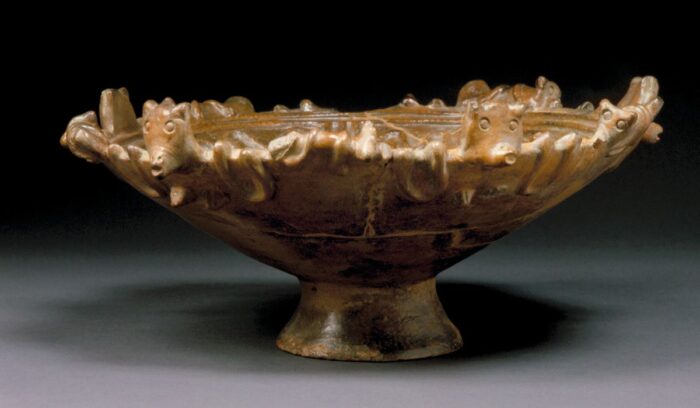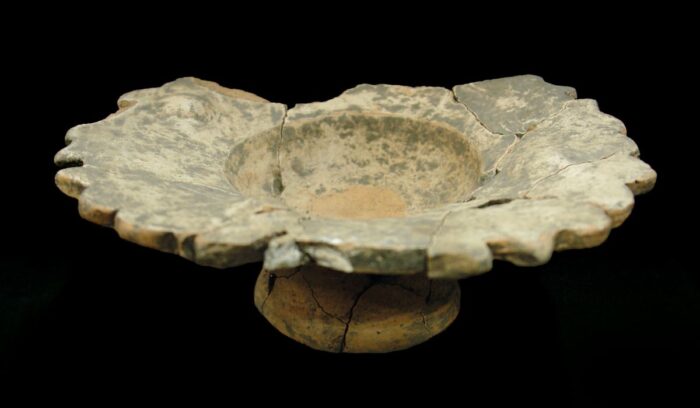Certain that the pieces of pottery scattered around her lab bench did not correspond to the region’s principal ceramic traditions—Marajoara and Tapajônica—and lacking a single clue regarding the fragments’ origins, one day in 2016 archaeologist Cristiana Barreto resigned herself to storing them in a cabinet. “I thought: ‘Enough! I’ll solve this mystery later,’” recalls Barreto, a researcher from the Emílio Goeldi Museum of Pará, in Belém. Upon opening the storage compartment, however, she came across vessels that had recently been restored. “My colleagues couldn’t determine the style of those objects either.” The puzzle began to be solved when Barreto noticed similarities between the findings. The shape of her fragments matched the rounded edges of the reconstructed vessels. Other shards featuring small animal or human representations also matched the ornamentation on some of the recently restored pots. “We didn’t know it yet, but we were looking at artifacts in the Koriabo style, one of the most enigmatic ceramic cultures of the tropics,” the researcher says. “We were quite surprised.”
They were astonished because until that moment the probability of finding Koriabo ceramics at archaeological sites in the lower Amazon region was considered remote. Since the 1960s, it has been believed that this type of pre-Columbian pottery was produced exclusively by the indigenous peoples who lived in what are now the Guianas and part of the state of Amapá, Brazil. The “mysterious” artifacts that Barreto had on her hands came from excavations conducted hundreds of kilometers away from these locations, in the Pará municipalities of Monte Alegre and Almeirim. Through information sharing with the archaeologists who have been working in the Guianas for years, the Goeldi researchers were able to confirm the findings of Koriabo ceramics in the lower Amazon. The results of this interaction, which began five years ago, are published in the book Koriabo: From the Caribbean Sea to the Amazon River, released in April.
“The exchange of data between research programs in Brazil, the Guianas, and the Caribbean showed that this ceramic style did, in fact, achieve an extraordinarily wide geographic distribution,” says Barreto, one of the editors of the book, which brings together 32 authors and is the fruit of a partnership between the Goeldi Museum, the National Center for Scientific Research (CNRS) in France, and the University of Leiden, in the Netherlands. Everything indicates that before European colonization there existed a very unique form of cultural expression that spread from the Caribbean region to the south bank of the Amazon River—an enormous area of approximately 1.5 million square kilometers (km²), larger than the size of Peru.
The book got its impetus during two international meetings at the Goeldi Museum, in 2014 and 2017, on archaeological ceramics found in the vast Amazon region. During the events, dozens of archaeologists, anthropologists, and linguists from countries such as Brazil, France, Germany, the Netherlands, and French Guiana shared their knowledge about different ceramic cultures, including the Koriabo. “At the time, I had found unidentified fragments in the municipality of Gurupá, at the confluence of the Xingu River with the delta of the Amazon River,” says archaeologist Helena Pinto Lima, also from the Goeldi Museum. “I presented some samples to colleagues and one of them commented, ‘This looks like Koriabo.’ From there, we started a collaboration.”
The scientist who put forward that guess—and got it right—was French archaeologist Stéphen Rostain, from the CNRS, who has been working at archaeological sites in the Guianas for decades. “Most of them are located along large rivers. The connection of villages via waterways probably explains the appearance of Koriabo ceramics in the lower Amazon,” he told Pesquisa FAPESP. Thanks to the dialogue the researchers established it became possible to map and analyze the geographical distribution of the Koriabo ceramic style, which spreads from the Caribbean, through the Guianas and along the coast of the Atlantic Ocean, down to the Xingu and Trombetas rivers (see map). The researcher explains that sites that date to the era after Europeans arrived in the Americas were found in the Antilles, in Central America. “This suggests a redistribution of the Koriabo style, as a result of the societal and territorial effects induced by colonization.”
River courses that start in the Guiana Shield and flow into the Amazon would have served, therefore, as communication and exchange routes between different indigenous communities. “This is one of the consensuses arrived at among the authors of the book,” Lima says. “As with other ceramic styles, the circulation of the Koriabo style took place through dense social networks through which different indigenous peoples moved.” These interconnections evidently did not depend exclusively on river routes. Recent studies have highlighted the importance of roads in connecting settlements during pre-Columbian eras (see Pesquisa FAPESP issue no. 299).
Archaeologist Eduardo Góes Neves, a specialist in Amazon archaeology at the Museum of Archaeology and Ethnology of the University of São Paulo (MAE-USP), explains that links between villages in the Caribbean, the Guianas, and the lower Amazon—dozens or hundreds of kilometers apart—were already known. “Recent research on the Koriabo culture, however, now presents stronger evidence of this exchange,” says Neves, who did not participate in the studies published in the book. Due to collaborative work between linguists and archaeologists, it was already known that there was a concomitant expansion of Arawak languages—originating in the western Amazon—with the production of various ceramic styles. “The geographic diffusion of the Arawak language took place over 2,500 years ago,” he says. In the case of Koriabo ceramics, the researchers believe the dispersion is linked to more recent geographic expansion by speakers of the Caribbean language group.
Another example is the circulation of muiraquitãs, small objects made of green stone, which appear at sites in the Caribbean, Venezuela, and the Brazilian Amazon. “In many places there was no such type of rock. One hypothesis to explain how the muiraquitãs ended up in these locations is the existence of well-structured trade networks, which existed in the region long before the colonial period,” the MAE researcher adds. For Neves, one of the book’s strong points is that it not only shows that such connections between these peoples had always existed, but that they persisted for some time after European colonization.
The oldest radiocarbon samples indicate that the Koriabo culture flourished after 1000 ACE and spread geographically until about 500 years ago, when Europeans first arrived in the Amazon. The Dutch, English, and French, as well as Portuguese missionaries took advantage of indigenous exchange networks to settle in the region. “We know Dutch forts were being built as early as 1560 in the lower Xingu. Koriabo pottery fragments were found in the same area,” says Lima.
The competition between European empires for dominion in the Americas contributed to an interaction between colonizers and indigenous peoples that was marked simultaneously by both conflict and cooperation (see Pesquisa FAPESP issue no. 302). “For Europeans, participating in exchange networks was a way to dispense with their products, in addition to providing contact with traditional knowledge about plants and local geography,” observes Barreto. “The objective was to effect a territorial occupation.”




